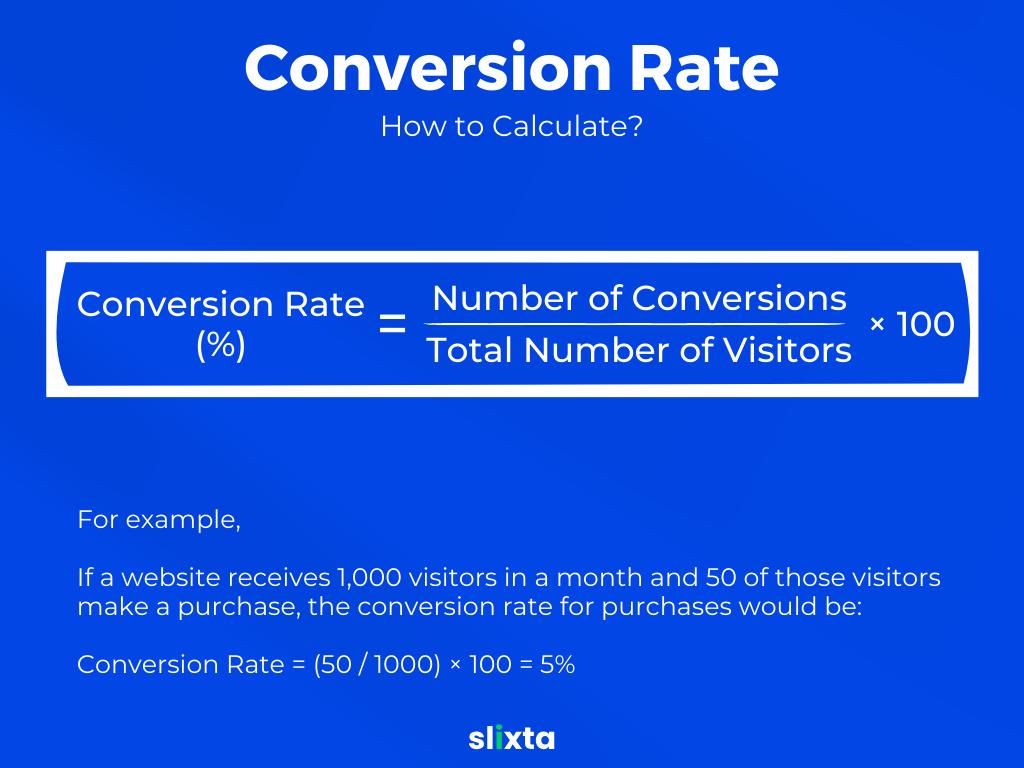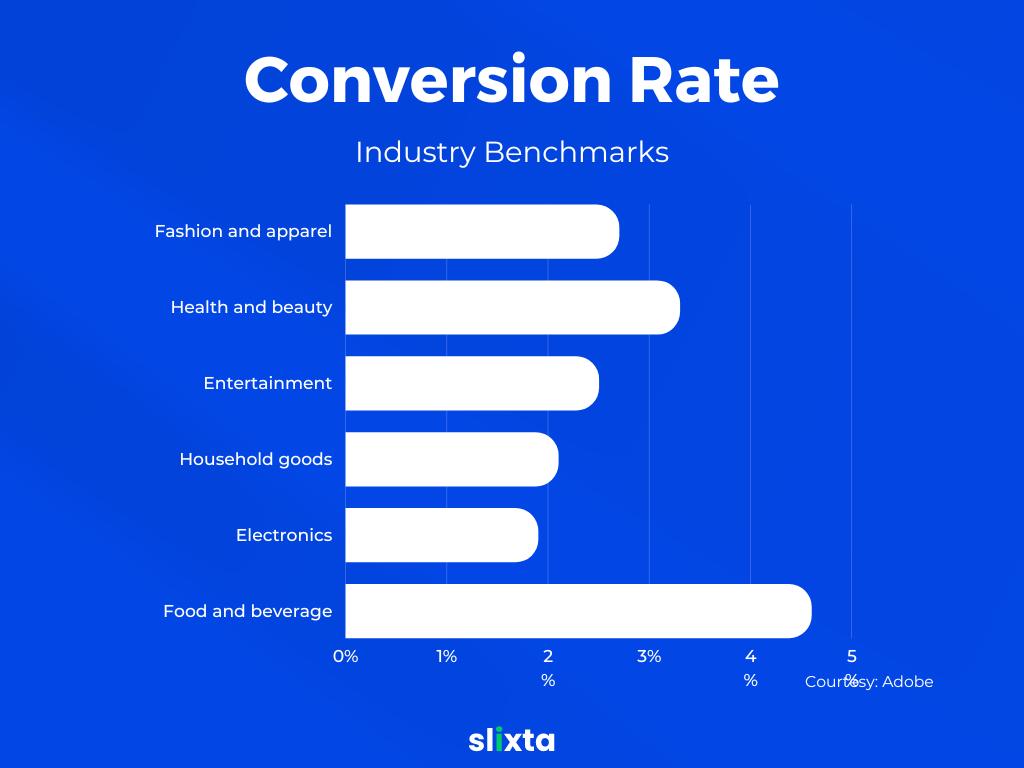Conversion rate refers to the percentage of website visitors who take a desired action, such as making a purchase, signing up, or completing a specific task. It's a critical metric in digital marketing and e-commerce, indicating the effectiveness of a website or campaign in achieving its goals.
Monitoring the success of your eCommerce store in line with your marketing plan can be made simple by tracking the conversion rate. Think of the conversion rate as a kind of score that reveals how many out of every hundred visitors are actually doing what your website hopes they would. It's like a performance indicator for your website.
When more people do what your website intends, such as making purchases or signing up, the conversion rate increases, which is a positive sign. Essentially, it's a way to see if your website is effectively getting people to take the actions that matter. In this blog, we'll discuss deeper into the concept of conversion rates and explore actionable steps to enhance them, helping your business thrive.
What is Conversion Rate?
A conversion rate refers to the percentage of website visitors, users, or potential customers who take a desired action or complete a specific goal out of the total number of visitors.
This action could be anything that aligns with a business's objectives, such as,
- Making a purchase
- Signing up for a newsletter
- Filling out a contact form
- Downloading a resource.
Conversion rates are often used in the context of online marketing, eCommerce, and website optimization. They help businesses assess the effectiveness of their digital strategies and identify areas for improvement. A higher conversion rate indicates that a larger proportion of visitors are successfully engaging with the desired actions, which can lead to increased revenue and a better return on investment.
Formula to Calculate Conversion Rate
The formula to calculate a conversion rate is:
Conversion Rate (%) = (Number of Conversions / Total Number of Visitors ) × 100
For example, if a website receives 1,000 visitors in a month and 50 of those visitors make a purchase, the conversion rate for purchases would be:
Conversion Rate = (50 / 1000) × 100 = 5%

What is a Good Conversion Rate?
Determining what constitutes a good conversion rate for your business is a nuanced task. It hinges on various factors, including your industry, target audience, and the specific goals you've set for your website. While a 2-5% conversion rate is often considered a respectable benchmark, it's essential to recognize that success can look different for different businesses. B2B companies, for instance, might aim for a lower conversion rate but with larger deal sizes, whereas B2C retailers may strive for higher rates with smaller transactions.
It's also important to note that industry standards are continually evolving, and what was considered a good conversion rate a few years ago may no longer hold true today. Keeping an eye on industry trends and benchmarks is crucial to ensure your business remains competitive.
Moreover, a good conversion rate isn't static. It's a dynamic metric that should be monitored and optimized regularly. Analyzing user behavior, conducting A/B tests, and refining your marketing strategies are all vital steps to improve your conversion rate over time. Remember, what's most important is not merely achieving a good conversion rate, but steadily increasing it to achieve your business's growth objectives.
Conversion Rate - Benchmarks
Let's examine some Conversion Rate Benchmark data:
According to Adobe:
- Global eCommerce website conversion rate: 2.58%
- US eCommerce website conversion rate: 2.57%
- Fashion and apparel: 2.7%
- Health and beauty: 3.3%
- Entertainment: 2.5%
- Household goods: 2.1%
- Electronics: 1.9%
- Food and beverage: 4.6%

Significance of Conversion Rate
The significance of conversion rate lies in its ability to gauge the effectiveness of a business's online presence and marketing efforts.
Here's why it's important:
Effectiveness Assessment: Conversion rate serves as a yardstick to measure how well a website or online store is translating visitors into desired actions, like purchases or sign-ups. It shows if your online strategy is resonating with your audience.
Performance Tracking
By tracking changes in conversion rates over time, you can monitor the impact of adjustments made to your website, marketing campaigns, or user experience. This helps you pinpoint what's working and what needs improvement.
Return on Investment (ROI)
A higher conversion rate means more successful customer actions, which leads to increased revenue. This directly impacts the return on investment for your marketing efforts and helps justify marketing budgets.
Targeted Optimization
Conversion rate analysis helps identify weak points in your website's user experience, sales funnel, or checkout process. This allows you to focus your efforts on specific areas to improve overall performance.
Decision Making
Conversion rates provide actionable insights for decision-making. For instance, if a particular product page has a low conversion rate, you can investigate and make necessary adjustments to boost its appeal.
Benchmarking
Comparing your conversion rates against industry benchmarks lets you know how well you're performing relative to your peers. This can inspire new strategies and tactics to stay competitive.
Efficient Resource Allocation
By knowing which parts of your website or marketing efforts are driving better conversion rates, you can allocate resources more efficiently toward those high-performing areas.
User Experience Improvement
A low conversion rate might indicate issues with user experience, causing visitors to leave without taking desired actions. This prompts you to enhance navigation, content, and overall site usability.
Tips to Improve Conversion Rate
- Clear Call-to-Action (CTA): Make your CTAs clear, prominent, and compelling. They should guide visitors toward the desired action with concise language and contrasting colors.
- Simplify Forms: Streamline your forms to minimize friction. Ask only for essential information and eliminate unnecessary fields. Shorter forms are more likely to be completed.
- Page Loading Speed: Ensure your website loads quickly on all devices. Slow-loading pages can lead to high bounce rates and abandoned carts.
- Mobile Optimization: With a growing number of users on mobile devices, optimize your website for mobile responsiveness to ensure a seamless experience for all visitors.
- Trust Signals: Display trust badges, security certifications, customer reviews, and testimonials to instill confidence in visitors and reduce any apprehensions they might have.
- Compelling Content: Craft persuasive and informative product descriptions, headlines, and landing page content. Showcase the benefits and value of your offerings.
- Clear Navigation: Make sure your website's navigation is intuitive and easy to follow. Visitors should be able to find what they're looking for without confusion.
- Exit-Intent Popups: Use exit-intent popups to offer special deals or incentives when users are about to leave your website, giving them a reason to stay or return.
- Personalization: Tailor content and recommendations based on user behavior and preferences. Personalized experiences can increase engagement and conversions.
- A/B Testing: Continuously experiment with variations of your pages, CTAs, headlines, and other elements using A/B testing to identify what resonates best with your audience.
- Fast Checkout Process: Simplify the checkout process with as few steps as possible. Provide guest checkout options and allow users to save their payment information for future purchases.
- Urgency and Scarcity: Create a sense of urgency or scarcity through limited-time offers, countdown timers, or limited stock availability to encourage immediate action.
- Visuals and Videos: Incorporate high-quality images and videos to showcase your products from different angles and in various use cases, helping visitors make informed decisions.
- Segmentation: Segment your audience and tailor your messaging to different groups based on their interests, behaviors, and preferences.
- Remarketing: Implement remarketing campaigns to target users who have previously visited your site but didn't convert. Remind them of your offerings and encourage them to return.
- Chat Support: Offer live chat support to assist visitors in real-time, answering their questions and alleviating any concerns they might have.
- Social Proof: Showcase real customer testimonials, case studies, and success stories to build credibility and demonstrate the value of your products or services.
- Optimize Images: Ensure that your images are appropriately sized and optimized for the web, so they don't slow down page loading times.
Conclusion
A strong conversion rate serves as a vital indicator of the effectiveness of your online presence and marketing efforts. It reflects how well your website engages visitors and encourages them to take desired actions, such as making purchases or signing up. By consistently analyzing and improving your conversion rate, you can optimize user experiences, refine your strategies, and ultimately drive business growth.
For more valuable insights and information, check out these recommended blogs:

